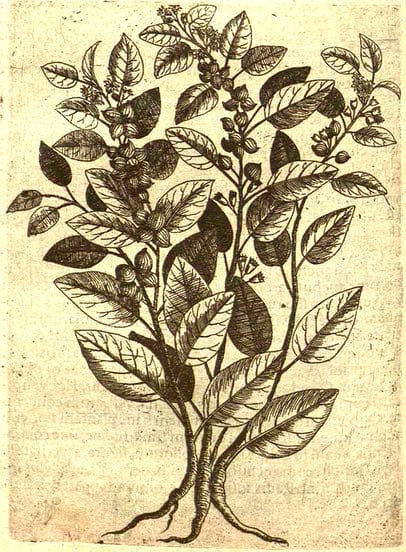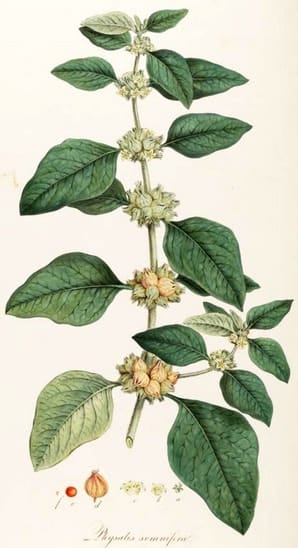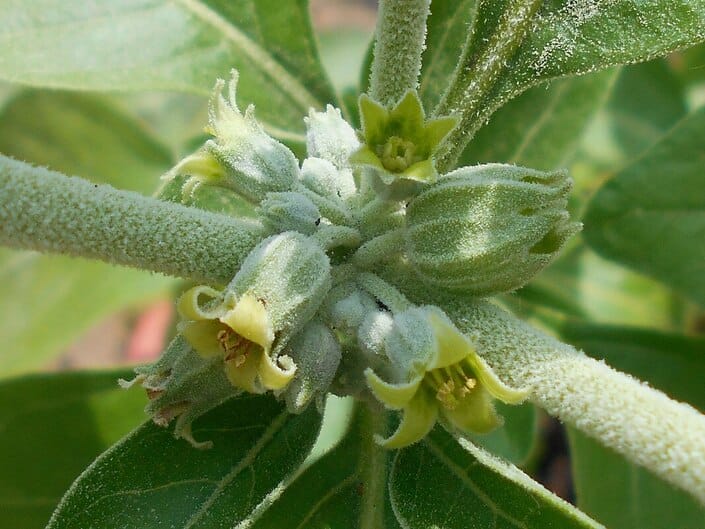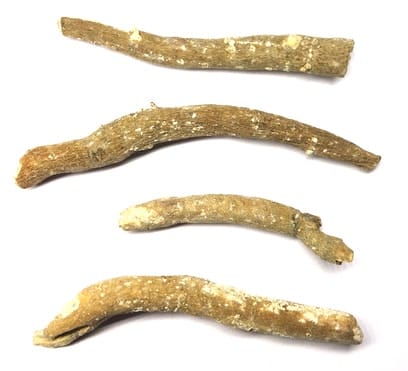Withania, AshwagandaWinter CherryAshwaganda (Ayurveda) Asgandh (Unani) Amukura (Siddha) Ba spru wa, A sho gandha (Tibetan) |

|
 De plantis exoticis libri duo, Alpini, 1629
De plantis exoticis libri duo, Alpini, 1629 |
 Flora Graeca, Sibthrop, Smith, 1819
Flora Graeca, Sibthrop, Smith, 1819 |
 Withania somnifera
Withania somnifera(Photo by Salicyna) (Wikimedia)
 Withania root (Adam, 2019)
Withania root (Adam, 2019)Botanical name:
Withania somnifera (syn. Physalis somniferum)
Parts used:
Root
There are 4 Grades commonly differentiated on the market:
A. 7cm or more long, white internally
B. 5cm long, white internally
C. 3–4cm long
D. small rootlets, slightly yellowish.
Temperature & Taste:
Warm, neutral in respect of moisture. Sweet
Classification:
3H. LACTAGOGUE 3I. APHRODISIACS 3J. INCREASE SEMEN
N. Tonics
Uses:
1. Tonifies the Spleen, Increases Qi:
-Fatigue, Poor Appetite, poor Digestion, weakness
-growth promoter in children
-tonic to mother and fetus during Pregnancy (avoid excessive doses)
-enhances Immunity and increases disease resistance
-adjunct in many chronic diseases including Rheumatism and Arthritis, Hepatitis, AIDS.
-restores strength after chronic illness and during convalescence
-altitude sickness
–Rasayana (tonic to the 7 Body Tissues)
2. Warms and Strengthens the Kidneys:
-Aphrodisiac; Impotence
-Male and Female Sterility (taken for several days following menstruation).
-Premature Aging and Senility; Neuro-degenerative diseases, Parkinson’s, Dementia etc.
-regarded as promoting Longevity.
3. Regulates Qi, Calms the Mind:
-Nervousness, Irritability, Alcoholism
-Anxiety, mild Depression; Mental Illness including Schizophrenia
-Insomnia associated with Stress.
4. Moves the Blood, Clears Wind-Damp, Resolves Swellings:
-Scrofula, Rheumatism and Tumors
-auxiliary in Cancer treatment; benefits immunity and has direct anti-cancer activity against various Cancer cell lines
5. Resists Poison:
-Traditionally used in Scorpion sting.
6. Benefits Sight:
-strengthens the Sight (combined with suitable ingredients)
7. Externally:
-applied to obstinate Ulcers and Rheumatic Swellings.
-Scrofula and glandular swellings, apply a paste of the fresh green root made into a paste with cow urine or warm water.
-in various skin diseases, the powdered root is mixed with oil and applied.
-a paste is made with milk to apply to the breasts to keep their shape
-powder is mixed with milk and applied to sagging breasts
-externally, the oil is applied to promote growth of the penis
-also used to restore a relaxed vagina
Dose:
Often taken with Milk for women and children; often taken with Ghee and Honey as a restorative tonic, in old age, chronic debility, impotence and senility.
Powder: 500mg–6 grams;
Decoction: 3–9 (to 12) grams;
Tincture (1:5 in 45% alcohol): 2–15mls (up to 15mls per day)
Ash: 1–2 grams;
Comment:
Withania is regarded as the best tonic in all Vata (Wind) disorders and for Vata constitution. Used where Wind is affecting the bones, joints, back, nerves and colon.
Correctives:
1. Tragacanth
2. Gum Arabic (Unani)
Substitutes:
1. Centaurea behen (Unani)
2. Ginseng
Main Combinations:
General Tonic:
1. Debility, Weakness, Emaciation, Digestive debility:
i. Withania with Long Pepper (Long Pepper enhances its tonic effects)
ii. Withania with Ginger, Long Pepper, Cinnamon, Cardamon (as in Withania Powder)
iii. Withania, Asparagus Shatavari (5 parts each), Triphala (15 parts), Trikatu (2 parts)
2. Immune deficiency:
i. Withania with Astragalus
ii. Withania with Chebula, Tinospora
iii. Withania with Ginseng, Ganoderma Ling Zhi
iv. Withania, Sida cordifolia, Licorice
v. Withania with Bdellium (Guggulu), Licorice
3. Tonic for the Elderly, and for Longevity:
i. Withania with Black Sesame, mixed with Honey to a paste, take Milk afterwards. “By observeing it for 12 days, even an old man will become young” (The Bower Manuscript, Ayurveda)
ii. Withania with Black Sesame, Long Pepper, Triphala
Nerve and Brain Tonic:
4. Nerve disorders with deficiency and aggravated Wind:
i. Withania with Centella, Calamus, Bacopa
ii. Withania, Chebulic Myrobalan, Sesame seed
5. Tonic for Wind disorders:
i. Withania, Chebulic Myrobalan
ii. Withania, Peony, Mistletoe
iii. Withania, Sesame seed, Licorice
iv. Withania, Chebulic Myrobalan, Aloeswood, Nutmeg, Clove
6. Brain tonic:
i. Withania, Walnut
ii. Withania, Peony, Mistletoe
iii. Withania, Frankincense, Cyperus Rotundus
iv. Withania with Centella, Chebulia Myrobalan
v. Withania, Chebula, Frankincense, Calamus
vi. for the aged, Withania with Ginkgo leaf, Rosemary, Basil, Siberian Ginseng
vii. Withania with Centella, Bacopa, Chebula, Indian Spikenard
7. Tonic for those studying or doing excess mental work:
i. Withania with Centella
ii. Withania with Rosemary, Sage
iii. Withania with Bacopa with Calamus and Honey
8. To enhance Memory:
i. Withania with Bacopa and Calamus
ii. Withania, Centella, Chebula, Indian Spikenard
iii. Withania with Bacopa, Centella, Oroxylum, Chebula, Indian Spikenard
iv. Withania, Bacopa, Centella, Indian Spikenard, Almond, Triphala
v. Withania, Bacopa, Almond, Date, Black Pepper made into an Electuary with Honey (Unani)
Reproductive Tonic:
9. As a strengthening tonic, for Impotence, Infertility and Senility:
i. mix Withania with ghee and honey
ii. Withania with Chebulic Myrobalan, Almond, Licorice mixed in ghee and honey
iii. Withania, Shilajit, Asparagus root
iv. Withania with Tribulus, Mucuna, Black Sesame seed, Frankincense (Ayurveda)
10. Reproductive tonic, for Males:
i. Withania, Orchis, Clove, Nutmeg
ii. Withania, Red Ginseng, Epimedium Yin Yang Huo
iii. Withania with Shilajit, Mucuna, Zinc Bhasma (oxide)
iv. Withania with Cordyceps, Solomans Seal, Asparagus racemosus, Orchis (as in Gso Byed 6 Pa of Tibetan Medicine)
v. Withania with Celastrus with Nutmeg, Saffron, Cinnamon, Costus, Asparagus root, Orchis
vi. Withania with Dodder seed, Asparagus root, Pyrethrum, Nutmeg, Salep (Orchis),
11. Reproductive tonic, for Females:
i. Withania with Dang Gui, Paeonia Bai Shao, Morinda Bai Ji Tian, Dioscorea Shan Yao
ii. Withania with Shatavari (Asparagus racemosus), Licorice, Sida cordifolia
iii. Withania with Shatavari (Asparagus racemosus), Rose, Cyperus rotundus
iv. Withania with Lotus Stamen Lian Xu, Asparagus root
v. Withania with Plumbago, Chlorophytum, Catechu, Cumin, Cinnamon, Iron Bhasma, Red Coral
12. Female Infertility:
i. Withania, Psoralea, Sida cordifolia (Ayurveda)
ii. Withania with Shatavari (Asparagus racemosus), Rose
13. To promote Breast development:
i. Scindapsus with Withania, Calamus, Costus
ii. To tone and firm the breasts, Symplocos racemosa with Withania, Iron sulphate, decocted in Sesame oil and applied
14. As an Aphrodisiac:
i. Withania is taken with Ghee as a tonic for old men
ii. Withania with Mucuna
iii. Withania with Salep (Orchis)
iv. Withania with Yohimbine
v. Withania with Argyreia root, Mucuna, Leptadenia, Pyrethrum root
vi. Withania with Epimedium Yin Yang Huo, Ginseng, Yohimbine
vii. Withania with Shilajit, Zinc Bhasma (oxide)
15. To increase Sperm:
i. Withania taken with Milk and/or Ghee
ii. Withania with Sesame seed, Almond, mixed with Ghee
iii. Withania with Salep (Orchis)
iv. Withania with Asparagus root, Licorice, Pistachio
v. Wiathnia, Shailjit, Zinc Bhasma
16. Spermatorrhea:
i. Withania with Long Pepper
ii. Withania with Schisandra
iii. Withania with Tribulus, Sesame, Mucuna mixed with Honey and Ghee (Ayurveda)
Childrens Tonic:
17. Tonic for Children
i. Powdered Withania is taken with Milk and Ghee
ii. Withania, Emblic Myorbalan, Asparagus Shatavari,
iii. Withania, Licorice, Almond
iv. Withania, Triphala, Date, Almond, Sesame Seed
v. Withania (10 parts), Centella (5 parts), Calamus (1 part)
18. Childhood nutritional impairment with fever, poor appetite, Withania with. Picrorhiza, Asparagus, Triphala
Arthritic disorders
19. Arthritis, Rheumatoid Arthritis:
i. Withania with Cyperus rotundus
ii. Withania with Ginger, Frankincense, Turmeric (this was studied in a clinical trial for Osteoarthritis of the knee and was found very effective in reducing pain and stiffness)
iii. Withania with Bdellium, Frankincense, Turmeric
iv. Withania, Frankincense, Cyperus rotundus, Zinc oxide (Bhasma)
v. Withania, Chebulic Myrobalan, Shilajit
vi. Withania with Celastrus, Bdellium, Frankincense
vi. Withania with Tanacetum umbelliferum, Orchis, Ginger, Colchicum, Coriander, Ammi
vii. Withania with Tanacetum umbelliferum, Colchicum (Sweet), Galangal, China root, Ginger (as in one version of Powder of Colchicum) (Safoof-e-Suranjan) (Unani)
20. Cervical spondylosis:
i. Withania with China root.
ii. Withania with Tanacetum umbelliferum, Orchis, Ginger, Colchicum, Coriander, Ammi
iii. Withania with Tanacetum umbelliferum, Colchicum (Sweet), Galangal, China root, Ginger (as in one version of Powder of Colchicum) (Safoof-e-Suranjan) (Unani)
Other:
21. Polycystic Ovary Syndrome (PCOS):
i. Withania, Tribulus
ii. Withania, Myrrh, Cyperus rotundus
22. Scrofula, Withania, Long Pepper, Honey, Ghee (Chakradatta)
23. Fibromyalgia, Withania, Kava, Black Cohosh
24. Consumption, Decoct Withania and Long Pepper and take with Ghee and Honey.
Major Formula:
Ashwagandha Avaleha (Withania Electuary)
Balivivan (Ayurveda)
Dhatuvallabha Churna (Ayurveda)
Powder to Strengthen in Pregnancy
Withania 3 Decoction (Ba spru gsum thang)
Cautions:
Generally Safe.
1. Caution in excess Heat or Bile, and for those with congestion (‘ama‘)
2. While it is used as a tonic for mother and fetus during pregnancy, this is only in compound; full doses of the single herb should be avoided. It is recommended not to take more than 3 grams daily during pregnancy.
3. Large doses are narcotic
Drug Interactions:
May poitentiate barbiturates and benzodiazepines
Main Preparations used:
|
‘This plant bears the Sanskrit names of Asvagandha, Turagi or Turangi, and Turagi-gandha, “smelling like a horse or mare”; Varaha-karni, “boar-eared”; Vrisha, “amorous,” &c. It is described in the Nighantas as tonic, alterative, pungent, astringent, hot and aphrodisiac, and is recommended in rheumatism, cough, dropsy, consumption and senile debility. Chakradatta recommends it in decoction with long pepper, butter and honey in consumption and scrofula. A ghrita or medicinal butter prepared by boiling together one part of the root with one part of clarified butter and ten of milk may be used in such cases. As an aphrodisiac and as a remedy for rheumatism the drug is usually combined with a number of aromatics, each dose contains about 30 grains of the root. It is also made into a paste with aromatics for local application in rheumatism. Indian Mahometan writers merely repeat what the Hindus say about this drug, and do not recognise in it the Kaknaj-el-manoum of the Arabs, which is supposed to represent the [?] of the Greeks, the description of which by Theophrastus agrees tolerably well with W. somnifera. Rheede calls it Pevetti, and states that a vulnerary ointment is prepared from the leaves. Prosper Alpinus (i., cap. 33) describes and figures it under the name of Solanum somniferum antiquorum, |
Roxburgh states that the Telinga physicians reckon the roots alexipharmic. Ainslie (ii. 14) says:— “The root as found in the medicine bazars, is of a pale colour, and in external appearance not unlike our gentian; but it has little sensible taste or smell, though the Tamool Vytians suppose it to have deobstruent and diuretic qualities, given in decoction to the quantity of about half a teacupful twice daily; the leaves moistened with a little warm castor oil, are a useful external application in cases of carbuncle.” The authors of the Bombay Flora say that the seeds are employed to coagulate milk like those of W. coagulane. We have tried the experiment and find them to have some coagulating power. The plant is very common along the shores of the Mediterranean, where it has always been reputed to be hypnotic. The properties of W. somnifera have recently been investigated by Dr. Trebut with regard to its reputation for hypnotic properties; he states that he has obtained an alkaloid from it which has hypnotic action and does not produce mydriasis. P. L. Simmonds (Amer. Journ. Pharm., Feb., 1891) states that the plant is employed at the Civil Hospital, Alger, as a sedative and hypnotic. (Pharmacographia Indica, Dymock, 1891) |
